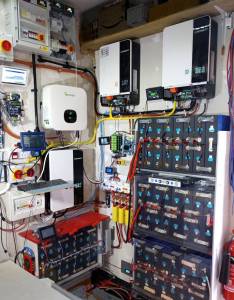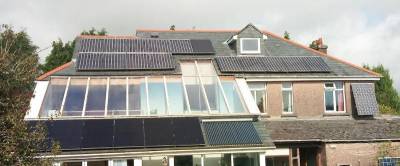Posted by: @transparentMany of these are marginally below 50MWh
Pedantry alert, did you mean 50MW (for G99 Type C)?
Posted by: @transparentAgain, we need to see this from the viewpoint of a DNO. Hundreds of individual houses with storage batteries is a far more stable solution than having large companies install batteries with megawatt capacity.
If each storage battery runs independently then this is true, however synchronisation does occur. ToU tariffs, Octopus Savings Sessions, shared control plane (e.g. many users of the same inverter manufacturer), shared grid signal/disconnection logic. In the past you've discussed what happens if a large cloud shades solar panels in an area (causing PV inverter output to drop).
It seems that the G98/G99 rules limit the usefulness of very large-scale battery storage to support the grid when things get really bad. As Seymour Cray said "If you were plowing a field, which would you rather use? Two strong oxen or 1,024 chickens?"
My gut feeling is that there will be a hierarchy of batteries throughout the system, from houses to electricity supply nodes (i.e. transformers) of all sizes, and especially in front of intermittent sources. That probably does not interact well with the way the current electrical industry is structured, but rules change to fit circumstances.
Posted by: @transparentIt's increasingly important for this Forum to provide as much help as possible to those wanting to install their own domestic-level battery storage.
and my experience so far has been just that - thanks everyone !
Posted by: @chickenbigPedantry alert, did you mean 50MW (for G99 Type C)?
Yes, thanks for that pedantry alert.
I was indeed referring to 50MW export rather than 50MWh storage capacity.
I had erroneously assumed that the battery could be exporting at C rate (ie it exports its entire capacity over the course of 1 hour)
So that others can follow what @chickenbig has picked up, here's the relevant chart derived from the guidance notes published by the ENA
I've shaded across the area which denotes the regulations which apply to G99 Class C.
You will note that such equipment is not regarded as a Power Generation Facility in England & Wales, and does not require a Generation Licence anywhere in GB
PS. There was extensive discussion of the 50MW export limit for G99 Class-C connections in the oral evidence given to the House of Commons Select Committee on Energy, 29th Nov 2023. A transcript can be downloaded from the Parliamentary website. Above that 50MW limit, generation connection proposals can be called in for evaluation under the Nationally Significant Infrastructure Projects (NSIP) rules, operated by the Planning Inspectorate rather than the Local Planning Authority.
Posted by: @chickenbigsynchronisation does occur. ToU tariffs, Octopus Savings Sessions, shared control plane (e.g. many users of the same inverter manufacturer), shared grid signal/disconnection logic
There are time-offsets built into our British Smart Meter technology, which are specifically intended to minimise synchronisation between sites in respect of demand, but not for export/generation.
Active Network Management (ANM) can be required as a condition which applies to commercial generation sites. However, it is only effective to prevent risk to the grid from over-voltage (above 253v at the single-phase level, if that helps with the understanding).
There is no supply security technology or strategy in GB which has the capability to ensure grid security in the event of under-voltage.
That scenario was what I alluded to in my earlier example of a cascade effect across the grid in rural areas.
Yes, the present regulations are becoming increasingly pushed to the limit in their ability to ensure energy security.
That's why the Government specifically put the word Security in the title of the newly-formed Dept of Energy Security and Net Zero in Feb'23.
There are ongoing conversations about the need for changes to the electricity connection rules.
I know that for certain because I'm involved in those conversations!
Fortuitously there are very few rules to restrict the installation of domestic storage batteries.
We need to view this as an important contribution towards energy security, even if there's no medal for doing so!
Save energy... recycle electrons!
Posted by: @transparentFortuitously there are very few rules to restrict the installation of domestic storage batteries.
We need to view this as an important contribution towards energy security, even if there's no medal for doing so!
so effectively, i could have as big a storage capacity as i wanted domestically, so long as the inverter doesnt allow any of the stored energy to be fed into the grid?
Yes indeed @misterb
My own present storage capacity is 56kWh and growing.
My export capability, for which the SEG payment can be applied, is limited to 3.68kW (16A per phase).
One of the regulations which needs changing is to incentivise those with in-house storage to 'flatten the curve' for demand/supply, rather than simply replenish batteries from the grid when it is cheaper to do so as dictated by a crude ToU tariff.
That responsibility will fall to the new Independent System Operator and Planner (ISOP), which comes into being during 2024. See discussion of ISOP over here on another topic.
Posted by: @chickenbigthe G98/G99 rules limit the usefulness of very large-scale battery storage to support the grid when things get really bad. As Seymour Cray said "If you were plowing a field, which would you rather use? Two strong oxen or 1,024 chickens?"
That argument doesn't hold when considering supply security.
Things would be regarded as 'getting really bad' when someone uses a 12-bore on your pair of oxen.
In those circumstances we need 1024 chickens...
... who would continue plowing for several minutes even if their heads were blown off!
This forum should be breeding chickens...
Save energy... recycle electrons!
56Kwh !! ........... that's some HB system !!!! are you harvesting solar (size?) or using TOU tariffs or even a mixture?
the following is a sort of explanation/verification of where/what i am trying to do and my reasoning behind it.
my daily use yesterday worked out at around 55kw off peak and 20kw peak - if i could move that 20kw peak use into off peak i could save £4.20 per day - even more if i turned on additional heaters (we have dimplex quantums and are not heating all the house at the moment) - the quantums use power for the fans and we have an A2A inverter (heat pump) that we could run at a higher temp.
So i assume that would bring it up to around a saving of £6 per day when its really cold - using a nominal number of 'cold' days (and therefore max need) of 15 days per month for Nov/Dec/Jan/Feb and 10 days per month for Oct/Mar sp @80 days then the saving would potentially be 80 x £6 = £480 per year during the colder months.
as i also have 4kw of PV which is on a Feed in Tariff, so i could potentially harvest all the production and still get my payments, that could make the 'warmer' 6 months almost free. My 'standby use' is around 300/400 watts per hour, so around 9kw per day, plus hot water heating (immersion heater) at off peak. if that equates to around 4kw then by adding them together starts to give me an idea of how much storage would make a difference.
my fag packet calculations are that if i had a minimum of 20kw that i could charge during off peak periods then it would be close to the optimum of what i need (no point adding 100kw of storage as it wouldnt be cost effective in my circumstances) but i would like to build some additional capacity into my system, so i will go with an additional 14.3kw (or pref replace my 14.3 and buy two 15kw - based on nothing other than personal choice)
having that extra capacity in the 'warmer' months might take out the troughs and i wouldnt need to use TOU periods, so reducing my payments
as with all things, it all comes down to initial outlay, is there any real point in saving £500 per year if it takes 20 years to cover the cost? however due to my FiT payments (PV system was paid off over 2 years ago) then it makes my projected total cost of @£7,500 a lot more palatable
i receive around £1000 per year from FiT - so that makes a payback of 7.5 years - but then adding savings @£500 per year makes it £1500 per year set against £7500 - so payback in 5 years at current rates (more savings if energy increases and FiT rates increase) seem to make my project a viable one.....
I'm using a mix of solar and grid charging for these batteries @misterb
There are presently no batteries here capable of export to the grid, although the system is sufficiently flexible that this can be altered.
I haven't kept track of changes made to solar PV arrays in the last 6-months, but I think they're rated somewhere around 6.4KW total, across four arrays. Again, this is flexible, and those arrays can be switched between inverters within a couple of 'PV-combiner' boxes.
The PV panels are from two different manufacturers. The Panasonic ones (no longer MCS-approved) provide lower tail-off of generation during days with less sunlight.
There isn't good correlation between the ToU tariff rates from Octopus and the actual availability of renewable generation in my area.
Please remember that adding additional storage capacity doesn't require you to also increase the number of inverters you have.
The price of lithium cells has been decreasing greatly during 2023, as has the cost of maritime shipping.
You can continue to add more batteries, thereby giving you greater resilience against supply fluctuations and outages over longer periods of time.
Save energy... recycle electrons!
For our house which requires ~9kW my calculations for us to get all of our power at non-peak rates we need a factor of 2 more battery capacity. We presently have a 9.5kWh battery and an additional 13kWh will be about right for us I think. That is at the design temp for the house (-2) to stay at 20C.
You need a battery design which is water proof to go outside and most manufacturers recommend a canopy cover which prevents snow build up, and a removable insulation cover for peak winter temperature.
I totally agree with other inputs to avoid lofts for the summer heat and also the weight for both batteries and inverters.
Good luck with getting a good price and since you are having solar panels you avoid vat anyway. As for how much solar, as much as is physically possible since the fixed cost of installation is covered by more generation. East-west is great since you get longer generation time for example.
2kW + Growatt & 4kW +Sunnyboy PV on south-facing roof Solar thermal. 9.5kWh Givenergy battery with AC3. MVHR. Vaillant 7kW ASHP (very pleased with it) open system operating on WC
@judith as from February 1st, 2024, there will be no VAT charged on solar energy storage batteries (as I posted in another topic last week). I have found that so far, at -2 degrees C, my Daikin 8kW ASHP plus the house draw for DHW plus lighting, cooking and other domestic needs including server and wi-fi etc. have been met by a 27 kW/h Powerwall battery being charged during two three hour (Octopus Cosy) lowest rate charges per day. We keep the whole house (98 sq. metres) at a constant 22.5 degrees C 24/7. Late November and early December provided a few days at that -2 degrees point and was useful to see how things performed - and that is well! My only complaint (along with every other consumer I imagine) is the exorbitant price of that energy! Regards, Toodles.
Toodles, heats his home with cold draughts and cooks food with magnets.
Posted by: @toodlesthere will be no VAT charged on solar energy storage batteries
I have written to HMRC for clarification on this VAT Notice (708/6).
a. It is unclear what rate of VAT applies to a Battery Storage unit if it does not require professional installation.
Does the sales outlet apply 0% in such a case?
b. It is unclear whether the 0% VAT rate applies only to the physical battery unit, or to the entire installation.
The previous iteration of the VAT Guidance for 'Installation of Energy Saving Materials' (Section-30, Schedule 8 of the VAT Act) included a 60% rule in an attempt to prevent installers from incorrectly apportioning the labour component of the work. But the updated guidance fails to state if that 60% rule still applies to the extension of the 0% category to Storage Batteries.
This is an inherent problem when HMG starts making minor tweeks to existing legislation. 🤨
Save energy... recycle electrons!
Posted by: @transparentif it does not require professional installation.
Does the sales outlet apply 0% in such a case?
The VAT notice applies to installers only.
How to account for VAT if you’re a contractor or subcontractor installing energy-saving materials and grant-funded heating equipment.
VAT is payable when one buys the equipment which will be installed, but then the contractor claims back the VAT once it is installed. That is how it is for basic stuff like insulation, so why change it!
Whether the installation of an extra battery counts as an energy saving measure will no doubt be clarified in the 2024 update of this note (I hope).
@chickenbig The following quote is from my Solar PV and Tesla Battery installer’s promotion round robin:
“The big news is that from February 1st, getting an energy storage battery will be VAT free. The government has made the move to extend VAT relief to standalone batteries, as well as batteries retrofitted to an existing solar array. Any battery or batteries fitted at the same time as solar panels will still be VAT exempt too.
We've always thought it absurd that standalone battery installations and retrofitted batteries were not VAT free, so we're really pleased this is due to be rectified. It also means if you're thinking about adding a battery to store your solar electricity for use at busier times, or if you want to add an additional Powerwall to your existing set up let's say, now is the perfect time!“
Reards, Toodles.
Toodles, heats his home with cold draughts and cooks food with magnets.
- 26 Forums
- 2,406 Topics
- 54.6 K Posts
- 180 Online
- 6,092 Members
Join Us!
Worth Watching
Latest Posts
-
RE: Please help with the settings ecodan
Are you trying to address any particular performance is...
By Sheriff Fatman , 3 hours ago
-
RE: Solis inverters S6-EH1P: pros and cons and battery options
🤣 Well, I never managed to get the HA solis "...
By Batpred , 5 hours ago
-
RE: Experience - New Build / Complete New Heating System
Your sap clculations should give you a heat loss figure...
By JohnnyB , 5 hours ago
-
RE: Vaillant aroTherm not heating with many faults
@editor hmmm, our engineers Rae, Craig, Naz, Rob and Ry...
By ASHP-BOBBA , 6 hours ago
-
RE: Post-Traumatic Heat Pump Stress Disorder
@editor Hi Mars. I totally agree with your comments. ...
By Richard24738 , 6 hours ago
-
RE: Recommended home battery inverters + regulatory matters - help requested
Indeed! And my apologies, I should have expected you...
By Batpred , 6 hours ago
-
RE: I’m glad the cold spell is over!
@editor as a reply for this date the 6th of Jan in o...
By Nursethescreens , 7 hours ago
-
RE: Heat loss based on gas usage
@jamespa Thanks. The numbers posted above were jus...
By Bash , 7 hours ago
-
RE: Heat pump not reaching flow temperature
I would describe this as either a fault or a configurat...
By JamesPa , 8 hours ago
-

RE: New Daikin 11kW Altherma 3M install - is it working as it should?
I forgot to mention: Octopus measured our heat loss at ...
By Toodles , 11 hours ago
-
RE: Considering MLCP (Multi-Layer Composite Pipe) for ASHP
Thanks Mars and thank you for reaching out to so many p...
By iotum , 11 hours ago
-
RE: Air source heat pump roll call – what heat pump brand and model do you have?
Forum Handle: @davec Manufacturer: Peak Energy Mode...
By DaveC , 11 hours ago
-
RE: Rate the quality of your heat pump design and installation
Well, the guy came out, turned the heat pump to max, we...
By razz , 12 hours ago
-
Midea R32 setup and bizarre running with lengthy off periods?
Hi I am new to the world of ASHP and have just had a re...
By Countryman Helmsley , 12 hours ago
-
RE: Setback savings - fact or fiction?
Given the weather has been relatively stable, the empir...
By Batpred , 12 hours ago
-
RE: GSHP WOES! Midland based engineer recommendations?
@editor That is very kind! Thank you so much.
By johnbroome , 13 hours ago
-

RE: ASHP Energy Consumption: Aira 12kW heat pump
@wally Hi I am not sure how large your house is b...
By TechnoGeek , 15 hours ago
-
RE: Predicted Heat Loss & Needs from MCS calcs vs EPC vs actual
I've been thinking along similar lines to @tim441 from ...
By Sheriff Fatman , 15 hours ago
-

Thanks, @technogeek. Good to hear about the accuracy. ...
By Majordennisbloodnok , 15 hours ago
-
RE: Advice for a novice on Mitsubishi Ecodan 6kW
In my case it was a very specific pattern of behaviour ...
By Sheriff Fatman , 16 hours ago









